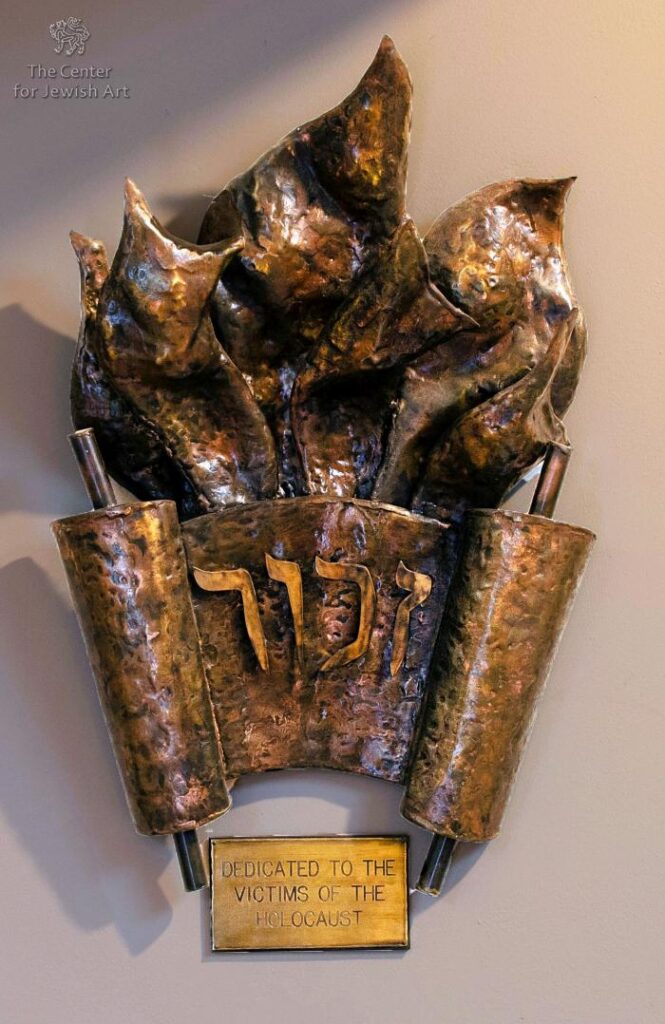ISJM and Partners Launch Worldwide Holocaust Memorial Monument Database
Three research organizations join efforts to create a comprehensive inventory and history of Holocaust memorial monuments worldwide.

Greenville, SC, USA, after 1990.
Photo by Mitch Litwer.

Martyrs of the Holocaust in Volos, Greece,
1998. Photo by Zev Radovan.
The digital database, “Holocaust Memorial Monuments” (cja.huji.ac.il/hmm/browser.php?mode=main) has been launched as a partnership project of the Center for Jewish Art, Hebrew University of Jerusalem; the Sue and Leonard Miller Center for Contemporary Judaic Studies/The George Feldenkreis Program in Judaic Studies, University of Miami, Florida; and the International Survey of Jewish Monuments, Syracuse, New York. The new database – still in a developmental stage – has been created to collect and preserve digital documentation about Holocaust memorial monuments worldwide, including standardized mapping, photography, description, and historical research. It also includes a growing bibliography on Holocaust and memorial monuments. The database records searchable and comparative information for educational, public policy, and academic use. It is a component of the Bezalel Narkiss Index of Jewish Art – the world’s largest repository of documentation on Jewish material culture. The database will also be accessible from the Miller Center and ISJM sites.
The total number of Holocaust memorial monuments in the world is unknown, but the project team estimates that it may be above 10,000. The first stages of the project include, in addition to developing the database itself, research about and photography of a wide selection of different types of Holocaust memorial monuments in various places; compilation of a bibliography; and preparation of a master list of memorial monuments that will be further documented in years to come. The project is supported by an International Advisory Committee consisting of leading scholars (cja.huji.ac.il/hmm/browser.php?mode=committee).
The pandemic delayed much on-site research, but pilot survey projects were carried out in Croatia (2021) and Greece, South Carolina and three South Florida counties (2022). Documentation in Vilnius, Lithuania is planned before the end of the year. Intensive work in Israel, Poland, Texas, and Long Island, New York, is planned to begin in 2023.

Forest of the Martyrs, Israel, 1959.
Photo by Vladimir Levin.

South Africa, 1959, 1995.
Photo by Louis Wald.
Partnerships are being established with country, regional or local institutions, to expedite documentation. One such partner is the Bet Tfila Research Unit at Technische Universität Braunschweig, Lower Saxony, Germany. A pilot project is planned in cooperation with the Lower Saxony Memorials Foundation and other partners. A first meeting took place on September 30, 2022 upon the invitation of the Lower Saxony State Commissioner Against Antisemitism.
The project has received funding in 2022 from the Conference on Jewish Material Claims
Germany and other sources. Additional funding from governments, foundations and individuals is being actively sought. The funding has enabled the creation of the digital database and web platform, the first pilot surveys, and the beginning of more comprehensive research. The database is designed to search by fields, including location, date, type, setting, artist, iconography, etc.
Holocaust memorial monuments can be found in many places, and their form and commemorative inscriptions often reflect the time (and politics) in which they were erected; the venue where they are installed; the audience they were intended to reach; and the victims, events, or place they are intended to commemorate. Many memorial monuments created soon after the Holocaust have been destroyed or altered, and changes are frequently made to existing monuments for many reasons, including changing political agendas and, regrettably, boorish disrespect for the work of previous generations.
The project allows for crowd sourcing for content. Individuals can submit information about memorial monuments through a form that is available on the website. That information is THEN fact-checked and edited before it is uploaded to the database. For the form, please see: cja.huji.ac.il/hmm/browser.php?mode=add_a_monument.
For further information or suggestions please feel free to contact:
Dr. Samuel Gruber (je********@***il.com),
Dr. Vladimir Levin (cj*@**********ac.il),
Dr. Haim Shaked (hs*****@***mi.edu)

